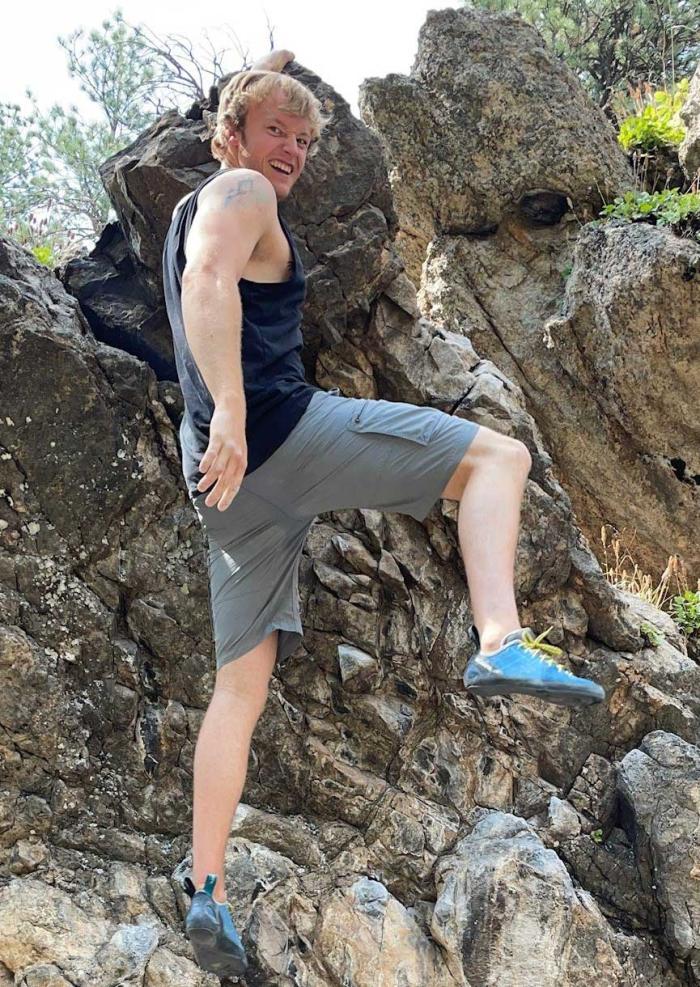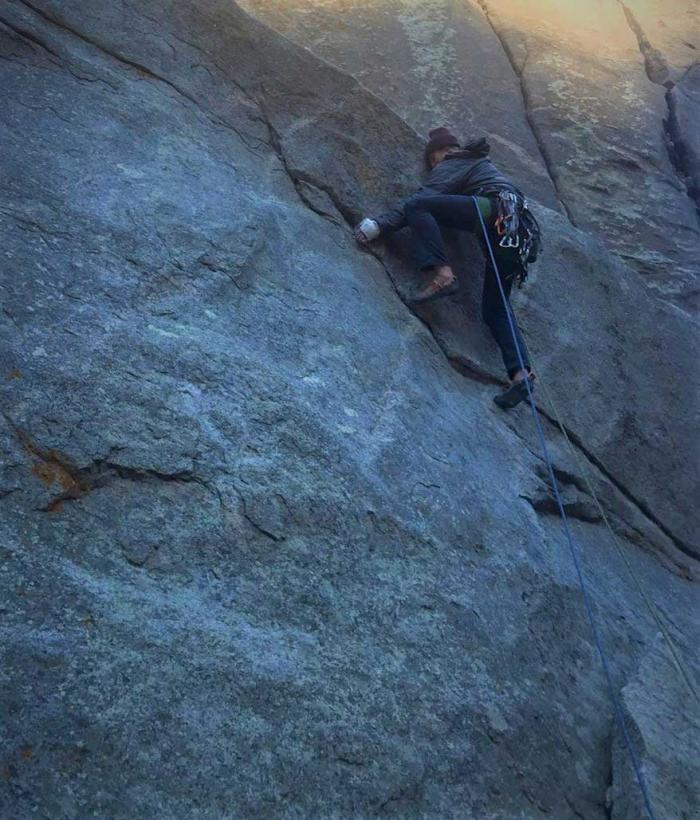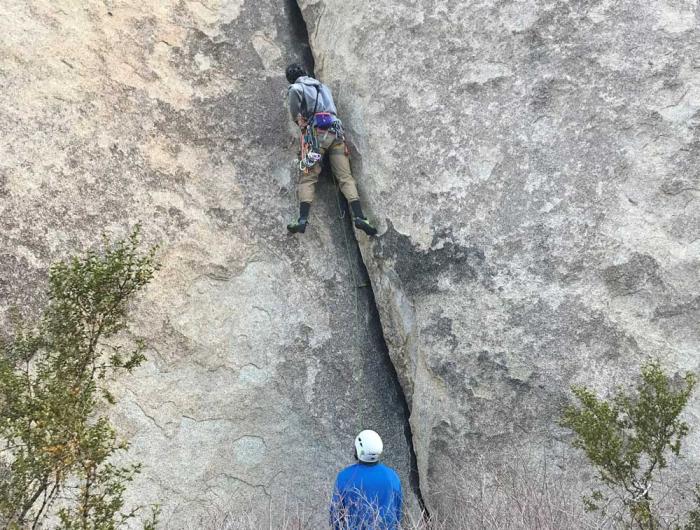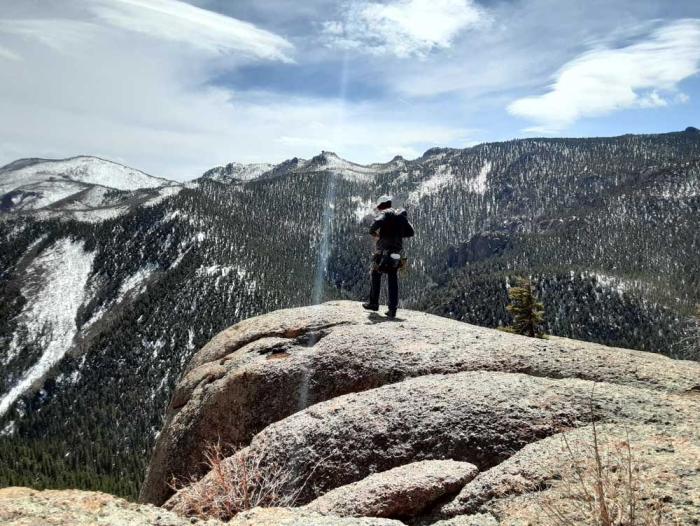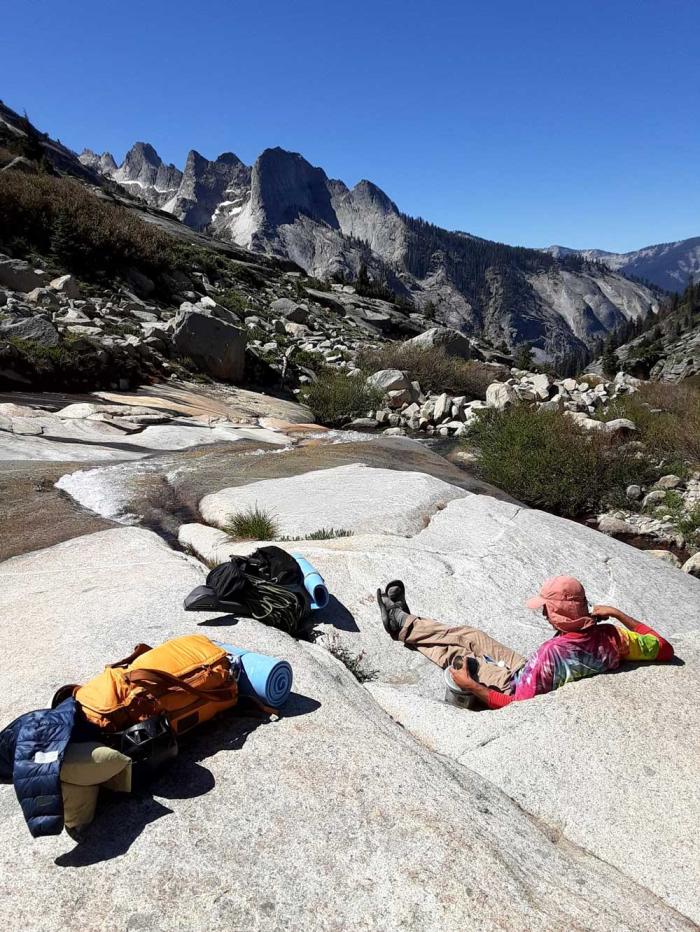For this rock climber, the smallest thing made the biggest difference
Up on the side of a cliff face, fingers and toes pressed into the smallest of ridges protruding from the wall, Ben Morgan looked up, planning his next move.
Then his foot slipped, and his body followed. Morgan was falling.
Morgan, who joined Denver Water in early 2019 and works at Ralston Reservoir as a facility operator maintaining safe water storage and delivery, started climbing in college. Over time he has gradually increased his climbing skills, skills which have helped with his career at Denver Water.
“Just like trusting my tools and my climbing partner allows me to be successful at climbing, my ability to help supply clean and safe drinking water to our customers allows them achieve success,” said Morgan. “Having a mission and goal like that is huge.”
His recipe for success? Starting small, building both mental and physical strength simultaneously, and being willing to move through fear to reach a goal.
A huge part of overcoming that fear included learning to trust his climbing gear and partner.
Learn more about Denver Water employees and their passions.
“Every time I’m out climbing, my equipment is saving my life and my climbing partner is saving my life,” Morgan explained.
The lifesaving nature of this trust was especially noticeable during a climb in Eldorado Canyon near Boulder in May 2022.
As the lead climber, the first member of his group to attempt the route that day, Morgan wedged protective gear into cracks in the rock face as he climbed, clipping his rope to each piece before he advanced upward.
Lead climbers repeat this sequence throughout a climb to maintain their own safety. After maneuvering a piece of gear between chunks of rock and clipping the rope into it, they continue their ascent, constantly on the lookout for the next opportunity to wedge more protective gear.
If a lead climber should fall before the next piece is placed, the fall will be dramatic.
The physics of climbing means that falls occurring between gear placements will be at least double the distance between the climber and the last piece of gear placed — and usually more. Outdoors, where good places to wedge gear can be difficult to find, lead climbers can experience falls that exceed 30 feet.
The danger in these falls usually lies not in the distance of the fall itself, but in the hazards climbers can encounter while falling. The very worst hazard is the ground.
Therefore, climbers and their climbing partners try to do everything possible to prevent a climber from hitting the ground during a fall.
It sounds counterintuitive, but falls that occur high up on a rock face can be safer, because there’s less risk of hitting the ground, than falls that occur relatively low on the rock face.
On that spring day, Morgan’s climb had him relatively low on the wall, close to the ground, meaning the physics of the climb were not in his favor.
Having climbed just 10 feet into his chosen route, the next stretch looming above was smooth rock with few spots into which he could place climbing gear, making the section both difficult to climb and dangerous.
A fall on this section would leave even the most seasoned climbing partner with little time to react.
But as Morgan continued his ascent, he discovered the smallest of cracks along the rock face, maneuvered his tiniest piece of gear into it and clipped in his rope.
“Probably too small to do anything,” Morgan thought, and turned his attention back to the challenge above.
During his college days, when Morgan’s climbing career was just gaining momentum, he faced great difficulty trusting his life to tiny bits of metal and meager lengths of rope.
As with most climbers, overcoming fear took effort.
“You can’t just wave your magic wand and make fear go away,” he explained.
“But you don’t want to get to a point where the fear is unmanageable. So, I took the time to do easier climbs and get more comfortable on the wall.”
Did a friend share this with you? Sign up here for Denver Water’s free weekly TAP email.
As the climbs got harder, he got better.
“You often have to calm your mind, trust your skills and abilities, and just go for it,” Morgan said.
“When you are 800 feet off the ground and you don’t have any way to back down, you have to find a way to deal with the fear. If you don’t, you are stuck.”
It was his years of experience that allowed him to continue up that smooth, difficult stretch in May.
As he continued his upward movement, Morgan shifted his weight from his left foot to the right. He wasn’t afraid.
“I’d actually climbed that route before, so I felt rather confident in it,” he remembered.
But as he surveyed the rock above, his attention slipped. So did his toe hold.
And as his foot slipped, his body followed.
Morgan was falling, the hard ground coming up fast.
“My buddy did everything right. He began taking slack out of the rope right away, even catapulting his own body toward the wall in order to take in more rope,” Morgan said.
“But because I was so low on the rock, less than 20 feet up, we both expected me to hit the ground. But he caught me, and that little piece of gear held and caught me, just a few feet from the dirt.”
Morgan’s climbing partner safely lowered him the last couple of feet. They shared a huge hug and a high-five, celebrating the safe landing.
Vision. Excellence. Passion. Purpose. Join us at denverwater.org/Careers.
“It turned out I was totally saved by that tiny piece of gear in that tiny crack. Without it my partner would not have been able to stop my fall,” Morgan said.
As it turned out, that tiny piece of gear was the only casualty of the day.
“We tried and tried to get it out of the crack, but that little guy was just ingrained in the rock,” Morgan explained.
“We left a little piece of us, of our gear, fixed there until someone comes along who is either really strong or really motivated and can rip that thing out of there.”
One of Morgan’s biggest takeaways from climbing is that it has given him the ability to come out of a difficult situation like the fall, and dust it off with a hug and a handshake and move on.
“My ability to command my fear totally helps me climb safely. If I can command my fear on the rock, I can command it in other areas of my life such as presenting in front of large groups.”


